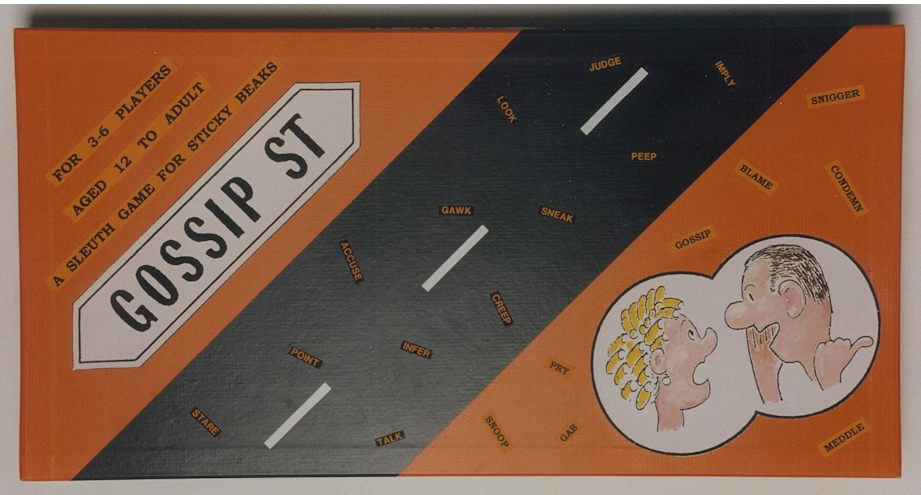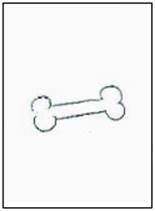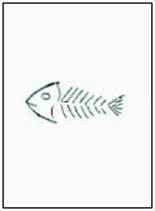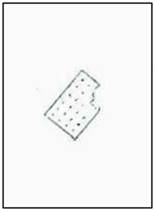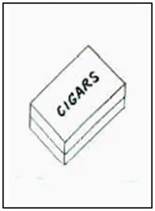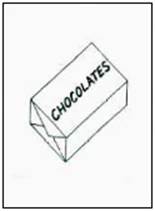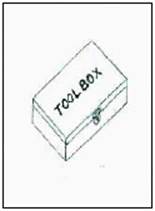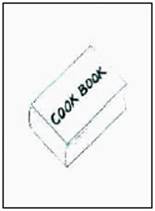A SLUETH GAME FOR STICKY BEAKS
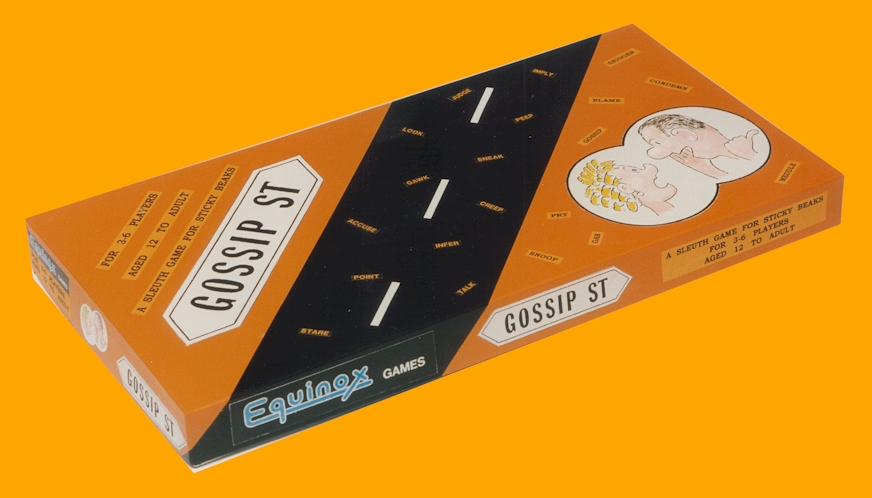
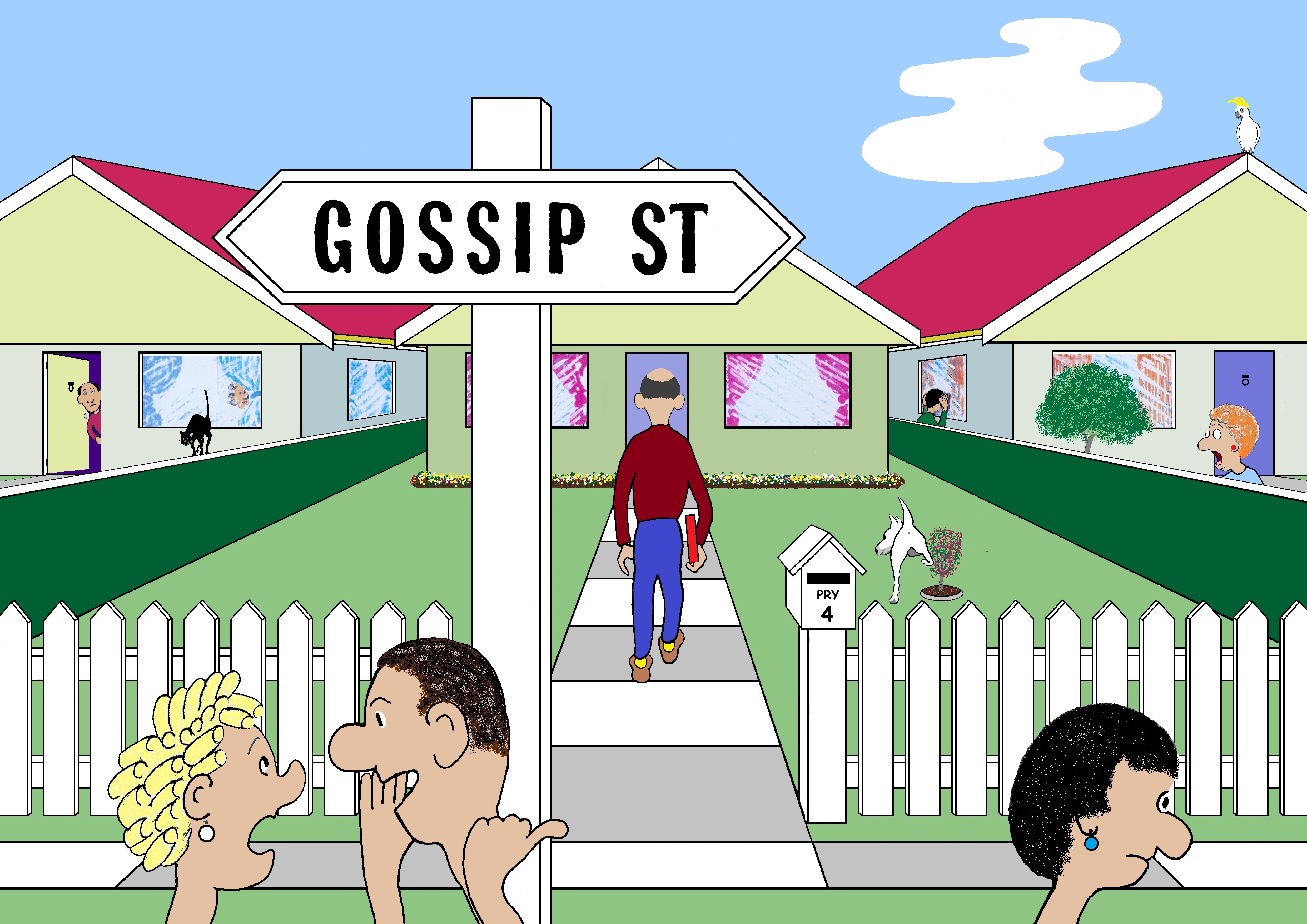
DESCRIPTION OF THE GAME
A board game designed for three to six players GOSSIP ST™ is perhaps
best described as a “sleuth or conclusion” game. Along the lines of the
classic CLUEDO™ game, GOSSIP ST™ is designed to be a far more
challenging game that combines observation, memory and deduction with
tactics, risk and chance.
CONCEPT
GOSSIP ST involves three to six players assuming some of the roles of
the twelve residents (six couples) of the busybody and scandal
mongering Gossip Street.
Players travel the footpath and pedestrian crossing (playing spaces)
leave calling cards, snoop in windows, find and hide incriminating
evidence while attempting to destroy the reputations of their
neighbours.
They will gather gossip, infer and accuse their neighbours of having
gossiping spouses, trouble making friends, adulterous lovers and
annoying pets. (Such as a dog that messes on their lawn, a fighting cat
that disturbs their sleep, a parrot that keeps squawking bad language
at passers by, or of being too lousy to have a pet).
At the same time they will hope their own reputation, won’t be
destroyed by the same accusations and that they can survive GOSSIP ST
OBJECT OF THE GAME
To survive Gossip Street with the least tarnished reputation or longer
than your neighbours (opponents). This is achieved by remaining
undetected while you and each other player attempt to reveal each
others own identity plus the identity of that persons spouse, friend or
lover and pet/no pet.
To win a player must avoid making five (or more) false accusations
whilst having at least one of his/her three (two people, one pet/no
pet) character cards undetected.
In other words: - To be correctly in order (own character, second
character and pet or no pet) accused in the one accusation will doom
your survival. To falsely accuse five times will doom your survival.
Once detected a player turns up his/her three character (two people
plus one pet or no pet) cards and concedes to a correct accusation and
cannot win. That same player can continue to play to help expose other
players, but not by sharing his/her gathered information.
Play continues until, detection or false accusations eliminate all but
one player. The winner eventually dying of loneliness and boredom on
GOSSIP ST.
RULES
DESCRIPTION OF PLAYING PARTS
1.
1 Playing board:
- The board represents a suburban street with three houses and a
footpath on either side, plus a pedestrian crossing at each end. Each
of the six houses has six color coded card squares marked in it
representing the pawn color of each player and where s/he places a
calling card. Each house is identified with the owner’s name (e.g. Mr.
and Mrs. Gab) and a house number. The footpath has sixteen stepping
squares on each side of the street and each pedestrian crossing has
three equalling a total of thirty-eight stepping squares (hereafter
playing spaces).

2.
12 Character cards or People cards (Mr. Sneak, Mrs. Sneak, Mr Nosey,
Mrs. Nosey, Mr Peep, Mrs. Peep, Mr Pry, Mrs. Pry. Mr Gab, Mrs Gab, Mr
Stare and Mrs Stare.
 |
 |
|
3.
6 Pet cards. (Dog, Cat, Parrot and three No Pet)
 |
 |
|
4. 300 Calling Cards.
(Thirty “chocolates”, thirty “cigars”, thirty “cookbook”, thirty
“toolbox”, thirty “dogbone”, thirty “fishframe”, thirty “cracker” and
ninety blank).
5.
6 Player Tokens. (red, white, blue, green, yellow and black).
6.
1 Die or Dice (1 to 6 )
7.
6 Dirt Files ( Note Pads)
8.
7 Calling card racks (six house and one “hide a clue”) clear plastic.
9.
1 Rule Book.
USE OF PLAYING PARTS
Playing Board
Players travel clockwise along the footpath and across the pedestrian playing spaces ( one for each number on the dice ).
Players respond to each different square as follows :-
House Path.
(Sneak,Nosey,Peep,Pry,Gab,Stare) When a player lands on a house path
s/he places a calling card on his/her color coded calling card space.
Go To ? House Path.
When a player lands on one of these spaces s/he throws the dice a
second time and moves his/her pawn to the house path of that number
indicated on the top face of the dice and places a calling card in
his/her color coded calling card space.
Snoop.
When a player lands on a “snoop” space s/he can take a look at any one
other players entire calling card stack (one stack only) in that
particular house (indicated by the footprints going to the window).
S/he can only look at one of the six possible stacks in the house.
Snoop ? House.
When a player lands on one of these spaces s/he throws the dice a
second time and moves his/her pawn to the snoop space adjacent to the
house number indicated on the top face of the dice and can look at any
(one only) players entire calling card stack in that house.
Gossip.
When a player lands on a “gossip” space s/he can pick up the top card
of any calling card stack in any house on the board. It must only be
the top card of a stack and must be within a house.
Hide A Clue.
When a player lands on a “hide a clue” space s/he can dispose of any
one calling card s/he possesses to the card space or stack marked on
the road ( center of the board).
Note:- Every player places his/her hide a clue cards on this same stack.
Find A Clue.
When a player lands on the one “find a clue space” s/he may take a look
at the last or top card only, placed on the “hide a clue” stack.
Infer.
When a player lands on a space marked “infer” s/he must select another
player and suggest (infer) to that other player :- e.g. “You are
Mrs.Pry. You’re having an adulterous affair with Mr.Nosey and you have
a squawking parrot”
If the player being inferred to holds any or all of these people or pet
cards s/he must respond by moving his/her playing pawn to the “Sit on
the Fence”space. If his/her pawn already sits on this space s/he must
move it one complete circuit and back to the “Sit on the Fence” space
indicating that s/he possesses one or more of the cards mentioned in
the inference.
Note:- As an inference is not the same as an accusation the names don’t
have to be in their character order. Meaning that from the example
given above that the suggestion could have been, “You are Mr Nosey
having an affair with Mrs Pry and you have a squawking parrot”.
Note Also:- If the inferring player had inferred correctly ( both
people and in their correct character order plus the correct pet), that
the player being inferred to does not have to concede and reveal
his/her identity as this is not an accusation but an inference.
Sit On The Fence.
Players only respond to the one “sit on the fence”space in response to
another players inference and only if in possession of one or more of
the character/pet cards mentioned.. If neither of those people or
pet/no pet cards are in the possession of the player being inferred to
s/he remains on the space s/he already occupies. The “sit on the fence”
is otherwise travelled over as if just a space on the board.
Accuse.
When a player lands on a space marked “accuse” s/he must select another
player and make an accusation. E.g. “I accuse you as being Mr. Peep,
having a messing dog and a trouble making friend Mr. Gab” or “I accuse
you Mr Stare of having a gossiping and busybody spouse (Mrs Stare) and
of being to lousy to have a pet”.
The accusation must be correct in every detail before the accused
player concedes and doesn’t survive (to win) GOSSIP ST and turns up
his/her character cards.
If the accusation is incorrect the accused player states “that is a
false accusation” but must then reveal (only to his/her accuser) one of
his/her people or pet cards.
Note:- The card may or may not reveal the identity of one of the
accusers suspected characters and if it does, the accuser may or may
not always be certain if it is the accused , first (self) or second
(spouse ,friend or lover) character (in the case of people cards). The
same card can be shown to the same accuser only twice to fend off a
false accusation. If the same accuser makes a third false accusation to
the same player, another character card must be revealed to the accuser.
When a player has made five false accusations in total s/he cannot survive (to win) GOSSIP ST.
Character cards
( people cards )
Each player is dealt two people cards. The first becomes their main
character or themselves. The second card or person will become either
there friend (same sex), lover or spouse (opposite sex).
Pet cards
( dog, cat, parrot or no pet )
Each player is dealt one pet card which could be the dog, the cat, the
parrot or one of the three no pet cards. Each player having been dealt
two people and one pet card, now records their first (self) characters
name, their friend, spouse or lovers name and their pet or no pet
without exposing their cards to the other players.
Now each player will initially receive fifty calling cards ( 5 of
each :- chocolates, cigars, toolbox, cookbook, dog bone, fish frame,
cracker and fifteen blank ).
Note:- Five
of the fifteen blank cards will represent having no pet.
Calling Cards
Each player will retain twenty calling cards 5 people, 5 pet or no
pet (blank) and 10 blank calling cards. Keep the only the ones applying
to them.
Examples of how calling cards are kept:-
Male to female (spouse or lover) ‘chocolates’
Female to male (spouse or lover) ‘cigars’
Male to male (friend) ‘toolbox’
Female to female (friend) ‘cookbook’
Messing dog (pet) ‘dog bone’
Fighting cat (pet) ‘fish frame’
Squawking parrot (pet) ‘cracker’
No pet ( ) ‘blank’
Plus ten blank.
To Play
Each player is handed a note pad (a dirt file).
The twelve people cards are shuffled and dealt (two per player) one at
a time around the table. Any left over are returned (unsighted by
anyone) to the box.
The first card dealt to each player becomes that players first
character and s/he notes the name under first character (dirt file).
The second card dealt to each player becomes that players “friend” (if
same sex) “lover” (if opposite sex and not spouse) “spouse” (if the
wife or husband of the first character). This is also noted under
second character (dirt file).
The six pet cards are now shuffled and dealt (one per player). Any left over are returned (unsighted by anyone) to the box.
This is also noted under pet (dirt file).
Each player now receives :- fifty five calling cards
| Five of each |
"chocolates" |
| Five of each |
"cigars" |
| Five of each |
"cookbook" |
| Five of each |
"toolbox" |
| Five of each |
"dogbone" |
| Five of each |
"fishframe" |
| Five of each |
"cracker" |
| and fifteen |
"blank" |
Each player now separates what cards apply to him/her and returns others (unsighted) to the box.
Keep cards as follows:-
| 1st character male |
|
|
| 2nd character female ‘lover or spouse’ |
“chocolates” |
(5) |
| |
“blank” |
(10) |
|
| 1st character female |
|
|
| 2nd character male ‘lover or spouse’ |
"cigars" |
(5) |
| |
"blank" |
(10) |
| 1st character male |
|
|
| 2nd character male ‘friend’ |
"toolbox" |
(5) |
| |
"blank" |
(10) |
| 1st character female |
|
|
| 2nd character female ‘friend’ |
"cookbook" |
(5) |
| |
"blank"
|
(10)
|
| Messing Dog |
"dog bone"
|
(5)
|
| Fighting Cat |
"fish frame"
|
(5)
|
| Squawking Parrot |
"cracker"
|
(5)
|
| No Pet |
"blank" |
(5) |
E.g. If first character male second female and have a messing dog :-
Keep, five chocolates, five dog bone and ten blank.
E.g. If first character female second female and have no pet :-
Keep, five cookbook and fifteen blank.
All other calling cards are returned to the box unsighted and each player should retain twenty.
Note
:- When picking up calling cards during play each player must take care
not to reveal it to his/her opponents before returning it to it’s
position back on the board.
Placing calling cards :-
Special Note :- Most important when placing calling cards in houses is
that they be placed in their correct color coded position and also as
follows :-
1.
Blank cards can be placed at any house but players own. E.g. If a
players first character is Mr Gab or Mrs Gab that player cannot leave a
blank calling card at the Gab house.
2.
Pet cards (dog bone/fish frame/cracker) can only be placed at both
sides of a players own house. That means his/her next door neighbours
house or (in the case of the four corner houses) his/her next door
neighbours and the house directly across the street.
A player cannot place a pet calling card at his/her own house.
E.g. If a players own house is the Mr&Mrs PRY number 4 house. S/he
can only leave a pet calling card at the NOSEY number 2 or the STARE
number 6 houses. E.g. If a players own house is the Mr&Mrs NOSEY
number 2 house. S/he can only leave a pet calling card at the SNEAK
number 1 or the PRY number 4 houses.
3.
“Chocolates” or “Cigars” calling cards can only be left at a players
own (first character) spouse house or his/her opposite sex (second
character) lovers house.
4.
“Cookbook” or “Toolbox” calling cards can only be left at a players own
(first character) house or his/her same sex (second character) friends
house.
Any type of calling card can be left on the card space “Hide a Clue” in the center of the board.
To Begin: -
Each player selects a colored playing pawn and places it on one
of the six different house path spaces (each player a different house
path) e.g. Pry path , Gab path, Nosey path etc.
Each player now places four of his/her twenty calling cards in at least
three different houses in the card spaces color matched to his/her pawn.
Throw dice (highest throw to begin). Play to move clockwise.
Note:- After responding to a “Go to ? House” or a “Snoop ? House” or
moving in response to another players inference players continue the
game from the space they are sent to.
Tips on collecting clues and using tactics.
1.
When landing on a “ Find a Clue” a player must remember who it was that
placed the last card on the “Hide a Clue” stack or s/he may mislead
him/herself with the wrong information.
2.
When an inference is made the reaction will give information to everyone.
a) If the player inferred to doesn’t respond at
all. Every other player can cross off the characters and pet situation
mentioned as relating to that person.
b) If the player does respond everyone else knows
s/he has at least one of the people or the pet that was mentioned which
may confirm an existing suspicion.
3.
When a player has already confirmed that another player has a
particular person or pet card/s. S/he can make an inference or
accusation in such a way as to have the accused draw out another
different card.
4.
Until a player has picked up the same pet card from two different
houses s/he cannot be certain of the owners house. But once having done
this s/he will have eliminated all but two people in determining
another players first person character and know which pet s/he owns.
